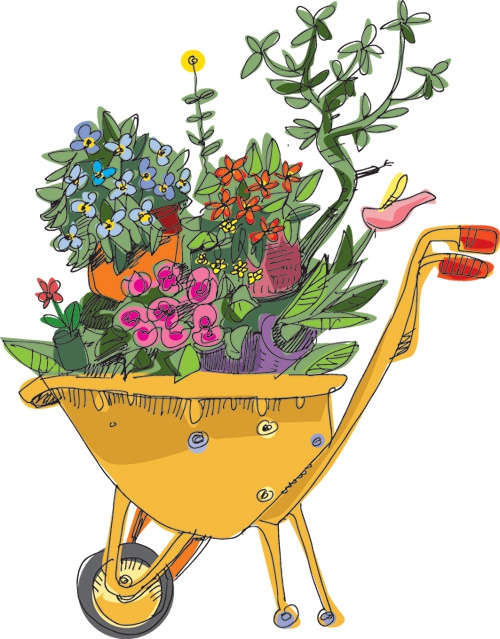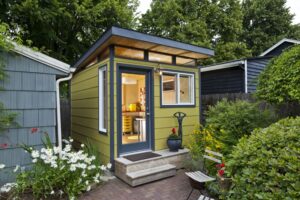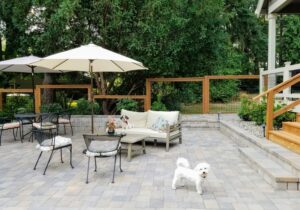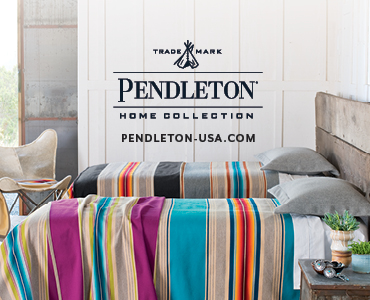1. Out your true landscape maintenance self to your garden designer before he or she redesigns Your Backyard.
Whether or not you like to spend hours in your yard with a bucket of gardening tools is important for a garden designer to know when designing your backyard, because a garden in which you spend time working is much different from one designed for relaxing in. If you’re someone who doesn’t want to constantly be dragging hoses around, you need to let your garden designer or landscaper know before you agree to put in a series of high-maintenance flowerbeds. “Sometimes if somebody has a birdbath in the back underneath a tree with some beautiful perennials at their back kitchen window that they can look at all season long, that can be enough,” says Laura Crockett, the owner of Garden Diva Designs in Hillsboro, Ore. “You really have to look at the kind of gardener you are before you come up with your backyard plan.”
2. Look to the period and style of your home for landscape cues to pick up on when you upgrade your backyard.
It’s important to see your house and backyard as connected rather than as separate entities. One of a garden’s functions is to create a framework for the architecture of your home. While you need not slavishly follow an off-the-shelf design of a bungalow garden for your Craftsman home, the style of your house does provide design cues. Within that framework, however, there’s plenty of opportunity to experiment. “If your house tells me it needs some form, but you want an informal garden, I’ll suggest we do the structure, but have a lot of informality within it, such as a perennial garden or an eclectic mix of plants,” says Kevin Teller, the owner of Teller Landscaping Company in Beaverton, Ore. “Within that garden, we can create special places to go or a focal point that balances and works within the structure that the house calls for.”
3. Think outside the box to work what you covet into your backyard redo.
If there’s something you particularly want in your backyard;a piece of garden art, a rose garden, a water feature; but it’s not appropriate to the style of your house, consider a creative way to work it into a backyard redesign. “Statuary doesn’t necessarily look good with a modern home, for example, but you can successfully work a statue into a backyard if you think about an unexpected place to display it,” says Ben Thomas of Ben Thomas Landscapers in Portland. “Don’t place it front and center; create a nook or a hidden alcove for it.”
4. Don’t smoke out the birds; Plan Barbecue areas and outdoor kitchens away from where birds nest.
A master plan is a good way to integrate all of your outdoor living wants and needs, and brainstorm the possibilities of your lot. Otherwise, you run the risk of designing a space that doesn’t match the potential of the yard. Just because you can or want to place something somewhere doesn’t mean you should. “For example, if one of your trees drops litter, don’t put a terrace beneath its canopy,” says Crockett. “You can still have the terrace, just locate it in a better place.” When making a master plan, some good questions to answer include: Do you want a garden that develops over time or do you want immediate gratification? How many years do you plan on living in this house and which family members will be living there during that time? How are you currently using your yard and what other activities would you like to incorporate? How much money are you willing to spend to get the kind of yard you want?
5. Think about Scale and proportion when planning your backyard’s new water feature.
Water features can work almost anywhere, regardless of topography. But if you own a small lot or live in a neighborhood where the houses are close together, you really need to think carefully about the placement of ponds, waterfalls and streams. To be effective, what looks like, say, a bit of stream, shouldn’t be in the center of your yard. “I like to tell people to avoid ‘Mt. St. Helens Syndrome,'” says Eamonn Hughes, the owner of Hughes Water Gardens in Tualatin, Ore. “You need to blend it into a corner of the yard, otherwise you have a pile of rocks spewing water out the top. I recommend people do an evergreen screen and have the water come out from beneath some foliage, so you create the illusion that your backyard has a creek running through it.”
6. Analyze your privacy needs and think about alternate fence materials before you run down to Home Depot and buy boring fencing materials.
One way to think about privacy in your yard is change your perspective. Rather than thinking about blocking your neighbor’s view, think about screening your own. That way the solution is built into the design of your yard, rather than just plunking something on the edge of your property line. And, different features require different privacy solutions. While you would want to shield a hot tub from above, you might need something different for your bedroom window. “Oftentimes people will take a tree and plop it right on the property line, but it takes some time for it to grow 20 feet and block the neighbor’s window,” says Crockett. “But if I brought that tree closer to my house, the canopy wouldn’t have to reach as far to block the angle to the neighbor’s window. With careful placement and thoughtful consideration, you can give yourself privacy without building a 25-foot-tall fence.” Other materials that can be used decoratively to screen a view are arbors, umbrellas, sailcloth and canvas.
7. Even if your backyard is still in the planning stage, change what you absolutely know you want to change.
“If there is something in your garden – whether it’s a piece of furniture, a planter bed or a deck – that you absolutely know you want to get rid off, go ahead and get rid of it right away,” says Thomas. “That way you’re working with a clean slate. Take it out so you can see what you have, then go from there and draw out things.”
8. Make sure the master plan works with your evolving needs, not against them.
A benefit of a well-designed master plan is that it includes the long view of how you’ll use your yard by taking flexibility and change into account. If you have young children, don’t plan all the activities of the backyard around them. At some point, you’ll want to change the yard, and if it’s been covered with swing sets, basketball courts and playhouses, you’re looking at a lot of time and money to make changes when the kids become teens and start spending more time in their bedrooms. By planning for the present as well as the future, you can have a yard that changes as your lifestyle changes. “If you want to have a backyard play structure for your kids, put some thought into the type you build,” says Thomas. “You should make it easy to move or take apart, which will allow you to easily change the way you use the space.”
9. Don’t forget about how the backyard will look as you view it from inside the house.
Think of what you want to see in your yard when you look outside from a bedroom window or from the living room. It helps visually to bring outdoor spaces indoors, which integrates the garden with the house. You may like to wake up in the morning and look out at a brightly colored flowerbed, for example. Or perhaps you’d like to watch ducks floating on a pond while you eat breakfast. “A garden should always relate to the indoors,” says landscape architect Marlene Salon, the owner of Marlene Salon Landscape Architect in Portland. “You need to know where the sightlines are to create a vista or a focal point from a window. It you integrate the flow from the indoors to the outdoors, it makes the garden more welcoming.”
10. While a garden can be low-maintenance, there’s no such thing as a garden that’s no-maintenance.
All gardens and yards require care and upkeep, say landscape professionals. If you’re going to go to the time, effort and expense to put in a new one, be prepared to put in some work so that it will survive. However, there are things you can do to decrease the amount of time you spend working in the yard. “It’s possible to create a beautiful garden with the level of maintenance you want,” says Salon. “One way of keeping the care somewhat more manageable is to limit the types of plants in the garden. Choose plants that cohabit manageably. If you have different plants with different growth patterns and different upkeep requirements, you’re creating a much more challenging gardening situation.” Another option, in addition to low-maintenance plants, is to add hardscape, such as walls, terraces and decks, which can look beautiful, but don’t require you to, say, deadhead flowers on a daily basis throughout the entire summer.
11. Plan for areas in your yard to serve more than one purpose.
If you have your heart set on a bocce court, remember that that space can only be used for that purpose and may possibly limit activities in other parts of the backyard. If you start marking off separate spaces for the dog, the kids, the flowers and outdoor eating, you may end up with areas that are too small for their intended uses. When redesigning a backyard, think of how its features and areas can be made multi-functional. For example, a simple patch of lawn can fit many uses. “If you have a terrace with a small lawn next to it, with a table and a couple chairs, that grass can provide a space for extra seating for guests or a place for kids to play,” says Salon.
12. Resist the urge to make big-ticket impulse purchases at Yard and garden shows.
While you can get a lot of great landscaping ideas from a yard and garden show, think beyond the salesmanship to how that 7-foot-tall wrought-iron gazebo will actually look in your postage-stamp-sized yard. Even if you particularly like a product, resist it if it won’t work in your yard. “Don’t just put in products or add something to your backyard because you think you have to have it,” says Teller. “There’s a lot of ‘fuss’ that people think they want to have in the garden because it’s become popular. You need to make sure that anything you add will enhance the garden and integrate well into the backyard’s existing landscape design.”
13. Embrace new outdoor-friendly materials, products and technologies that can make outdoor living a bigger part of your family’s lifestyle.
Spaces for gardens are becoming smaller, and, in many urban areas, so are homes. As a result, outdoor space and indoor space are becoming more connected, which creates new design opportunities. “The demand for space outside the home has increased, so the integrated home and garden is a huge trend,” says Crockett. “Plus, technology has improved the usability of the outdoors and there are excellent outdoor fabrics and lighting that allow you to stay outside and enjoy a summer evening. Options such as an outdoor natural gas fireplace simply weren’t possible 30 years ago.”
14. Create a yard that takes advantage of Oregon’s great outdoor climate.
Oregonians like to complain about the weather. While it’s true that some parts of the state get a lot of rain, the state’s natural environment makes spending time in the outdoors a pleasure. If you create a yard that invites you outside to enjoy it, you will end up using it. “In comparison to other parts of the country, Oregon is relatively pest-free when it comes to bugs, and it’s actually possible to enjoy the garden after the sun goes down,” says Salon. “One of the things that’s so enjoyable about our region is the ability to be outside. In this climate, you don’t need to screen in yourself. If you have covered outdoor space, you can still be out even if the weather starts going in the direction of rain.”
15. Even if you downsize, you don’t have to say good-bye to gardening.
If you live in a townhouse or condo or move to a house with a tiny yard, you don’t to give up your green thumb. There are many ways to bring greenery to an urban landscape or a very small space. Large flowerpots, portable planters, container gardens and water bowls are some of the options for small-scale gardens. “You can put little bronzes or floating glass balls in water bowls,” says Hughes. “You can be quite decorative with them and change them out depending on the season. It’s like a piece of furniture and ornamentation. You can swap out different elements and have fun with them.”
16. Before you invest in plants, shrubs and trees, spend some bucks on an irrigation system to keep them alive.
An irrigation system may seem like a luxury, but unless you always remember to water or make plans for your yard to be watered when you’re away, an irrigation system can protect your investment in greenery. This is particularly important in the first couple years while the plants are getting established. According to Teller, the problem is that many homeowners don’t know how to set up their irrigation systems properly. The water is often blasted onto the yard for 15 minutes at a time, which means that instead of soaking into the ground, the water runs off and is wasted. “You want to water like nature does,” he says. “It often rains in a way that the water has a chance to penetrate. I recommend using three starting times: Start with five minutes, wait half an hour and then do five minutes more. If your yard needs it, do five minutes after another half an hour. That way the water soaks and has time to penetrate, which makes an irrigation system more effective and can save water.” While the overall cost of putting in an irrigation system depends on the size of your yard, it costs about $1,200 per zone.
17. Think beyond your property line.
While your neighbors might mind if you borrow their tools, they probably won’t mind if you borrow their view. A yard provides the opportunity to frame a variety of sights beyond what you see out your back door. Vistas of trees, mountains and sky can be seen beyond the yard, and a garden can be designed to enhance an extended sightline. “In a small yard, there’s often a borrowed view – trees and sky – that goes way beyond your backyard that can be a real asset by designing the garden to enhance these positive borrowed views and screening the negative borrowed views,” says Salon.
18. Some gardeners are from mars and some are from venus: Realize that it’s important for couples to find a common language before designing a backyard together.
In a household with more than one gardener, planning a yard can be a relationship test. A good way for a couple to start a conversation about what their backyard could become is to mark up a detailed diagram or schematic of their lot with each partner’s wants, needs and absolute must-haves. “Most homeowners function as a partnership,” says Crockett. “There’s a wife and a husband – or there are two people – who are involved in making the garden happen. That means they need to have a plan for discussing their hopes and dreams and ideas for what they want to do with the backyard. They need to come together and look at the site in an objective way, otherwise they’ll just be out in the backyard flailing their arms around saying, ‘I want a seating area there and something tall here.’ Analyzing and discussing how you each want to use the space is a good exercise, but it can take a while.”
19. Don’t be afraid to make a statement with your yard.
An amazing yard is one which not only fits with your house and your lifestyle, but that also inspires other people to think about their gardens in new ways. “It’s good to be willing to make some kind of statement – to have the kind of backyard that people come back to, wave when they see you in it and maybe even take pictures of,” says Thomas. “Those are the really fun projects, when you work with someone who has a willingness to just do it, to roll with the confidence of their choices.”










